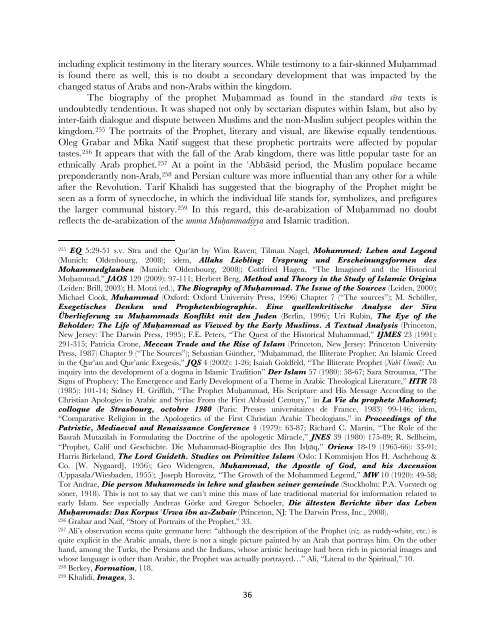“Anyone who says that the Prophet is black should be killed”: The ...
“Anyone who says that the Prophet is black should be killed”: The ...
“Anyone who says that the Prophet is black should be killed”: The ...
You also want an ePaper? Increase the reach of your titles
YUMPU automatically turns print PDFs into web optimized ePapers that Google loves.
including explicit testimony in <strong>the</strong> literary sources. While testimony to a fair-skinned MuÈammad<br />
<strong>is</strong> found <strong>the</strong>re as well, th<strong>is</strong> <strong>is</strong> no doubt a secondary development <strong>that</strong> was impacted by <strong>the</strong><br />
changed status of Arabs and non-Arabs within <strong>the</strong> kingdom.<br />
<strong>The</strong> biography of <strong>the</strong> prophet MuÈammad as found in <strong>the</strong> standard sÊra texts <strong>is</strong><br />
undoubtedly tendentious. It was shaped not only by sectarian d<strong>is</strong>putes within Islam, but also by<br />
inter-faith dialogue and d<strong>is</strong>pute <strong>be</strong>tween Muslims and <strong>the</strong> non-Muslim subject peoples within <strong>the</strong><br />
kingdom. 255 <strong>The</strong> portraits of <strong>the</strong> <strong>Prophet</strong>, literary and v<strong>is</strong>ual, are likew<strong>is</strong>e equally tendentious.<br />
Oleg Grabar and Mika Natif suggest <strong>that</strong> <strong>the</strong>se prophetic portraits were affected by popular<br />
tastes. 256 It appears <strong>that</strong> with <strong>the</strong> fall of <strong>the</strong> Arab kingdom, <strong>the</strong>re was little popular taste for an<br />
ethnically Arab prophet. 257 At a point in <strong>the</strong> #Abb§sid period, <strong>the</strong> Muslim populace <strong>be</strong>came<br />
preponderantly non-Arab, 258 and Persian culture was more influential than any o<strong>the</strong>r for a while<br />
after <strong>the</strong> Revolution. Tarif Khalidi has suggested <strong>that</strong> <strong>the</strong> biography of <strong>the</strong> <strong>Prophet</strong> might <strong>be</strong><br />
seen as a form of synecdoche, in which <strong>the</strong> individual life stands for, symbolizes, and prefigures<br />
<strong>the</strong> larger communal h<strong>is</strong>tory. 259 In th<strong>is</strong> regard, th<strong>is</strong> de-arabization of MuÈammad no doubt<br />
reflects <strong>the</strong> de-arabization of <strong>the</strong> umma MuÈammadiyya and Islamic tradition.<br />
255 EQ 5:29-51 s.v. SÊra and <strong>the</strong> Qur"§n by Wim Raven; Tilman Nagel, Mohammed: Le<strong>be</strong>n and Legend<br />
(Munich: Oldenbourg, 2008); idem, Allahs Liebling: Ursprung und Erscheinungsformen des<br />
Mohammedglau<strong>be</strong>n (Munich: Oldenbourg, 2008); Cottfried Hagen, “<strong>The</strong> Imagined and <strong>the</strong> H<strong>is</strong>torical<br />
MuÈammad,” JAOS 129 (2009): 97-111; Her<strong>be</strong>rt Berg, Method and <strong>The</strong>ory in <strong>the</strong> Study of Islamic Origins<br />
(Leiden: Brill, 2003); H. Motzi (ed.), <strong>The</strong> Biography of MuÈammad. <strong>The</strong> Issue of <strong>the</strong> Sources (Leiden, 2000);<br />
Michael Cook, Muhammad (Oxford: Oxford University Press, 1996) Chapter 7 (“<strong>The</strong> sources”); M. Schöller,<br />
Exeget<strong>is</strong>ches Denken und <strong>Prophet</strong>enbiographie. Eine quellenkrit<strong>is</strong>che Analyse der SÊra<br />
Ü<strong>be</strong>rlieferung zu MuÈammads Konflikt mit den Juden (Berlin, 1996); Uri Rubin, <strong>The</strong> Eye of <strong>the</strong><br />
Beholder: <strong>The</strong> Life of MuÈammad as Viewed by <strong>the</strong> Early Muslims. A Textual Analys<strong>is</strong> (Princeton,<br />
New Jersey: <strong>The</strong> Darwin Press, 1995); F.E. Peters, “<strong>The</strong> Quest of <strong>the</strong> H<strong>is</strong>torical Muhammad,” IJMES 23 (1991):<br />
291-315; Patricia Crone, Meccan Trade and <strong>the</strong> R<strong>is</strong>e of Islam (Princeton, New Jersey: Princeton University<br />
Press, 1987) Chapter 9 (“<strong>The</strong> Sources”); Sebastian Gün<strong>the</strong>r, “MuÈammad, <strong>the</strong> Illiterate <strong>Prophet</strong>: An Islamic Creed<br />
in <strong>the</strong> Qur’an and Qur’anic Exeges<strong>is</strong>,” JQS 4 (2002): 1-26; Isaiah Goldfeld, “<strong>The</strong> Illiterate <strong>Prophet</strong> (NabÊ UmmÊ): An<br />
inquiry into <strong>the</strong> development of a dogma in Islamic Tradition” Der Islam 57 (1980): 58-67; Sara Stroumsa, “<strong>The</strong><br />
Signs of Prophecy: <strong>The</strong> Emergence and Early Development of a <strong>The</strong>me in Arabic <strong>The</strong>ological Literature,” HTR 78<br />
(1985): 101-14; Sidney H. Griffith, “<strong>The</strong> <strong>Prophet</strong> MuÈammad, H<strong>is</strong> Scripture and H<strong>is</strong> Message According to <strong>the</strong><br />
Chr<strong>is</strong>tian Apologies in Arabic and Syriac From <strong>the</strong> First Abbasid Century,” in La Vie du prophete Mahomet;<br />
colloque de Strasbourg, octobre 1980 (Par<strong>is</strong>: Presses universitaires de France, 1983) 99-146; idem,<br />
“Comparative Religion in <strong>the</strong> Apologetics of <strong>the</strong> First Chr<strong>is</strong>tian Arabic <strong>The</strong>ologians,” in Proceedings of <strong>the</strong><br />
Patr<strong>is</strong>tic, Mediaeval and Rena<strong>is</strong>sance Conference 4 (1979): 63-87; Richard C. Martin, “<strong>The</strong> Role of <strong>the</strong><br />
Basrah Mutazilah in Formulating <strong>the</strong> Doctrine of <strong>the</strong> apologetic Miracle,” JNES 39 (1980) 175-89; R. Sellheim,<br />
“<strong>Prophet</strong>, Calif und Geschichte. Die Muhammad-Biographie des Ibn Isȧq,” Oriens 18-19 (1965-66): 33-91;<br />
Harr<strong>is</strong> Birkeland, <strong>The</strong> Lord Guideth. Studies on Primitive Islam (Oslo: I Komm<strong>is</strong>jon Hos H. Aschehoug &<br />
Co. [W. Nygaard], 1956); Geo Widengren, MuÈammad, <strong>the</strong> Apostle of God, and h<strong>is</strong> Ascension<br />
(Uppasala/Wiesbaden, 1955); Joseph Horovitz, “<strong>The</strong> Growth of <strong>the</strong> Mohammed Legend,” MW 10 (1920): 49-58;<br />
Tor Andrae, Die person Muhammeds in lehre und glau<strong>be</strong>n seiner gemeinde (Stockholm: P.A. Vorstedt og<br />
söner, 1918). Th<strong>is</strong> <strong>is</strong> not to say <strong>that</strong> we can’t mine th<strong>is</strong> mass of late traditional material for imformation related to<br />
early Islam. See especially Andreas Görke and Gregor Schoeler, Die ältesten Berichte ü<strong>be</strong>r das Le<strong>be</strong>n<br />
MuÈammads: Das Korpus #Urwa ibn az-Zubair (Princeton, NJ: <strong>The</strong> Darwin Press, Inc., 2008).<br />
256 Grabar and Naif, “Story of Portraits of <strong>the</strong> <strong>Prophet</strong>,” 33.<br />
257 Ali’s observation seems quite germane here: “although <strong>the</strong> description of <strong>the</strong> <strong>Prophet</strong> (viz. as ruddy-white, etc.) <strong>is</strong><br />
quite explicit in <strong>the</strong> Arabic annals, <strong>the</strong>re <strong>is</strong> not a single picture painted by an Arab <strong>that</strong> portrays him. On <strong>the</strong> o<strong>the</strong>r<br />
hand, among <strong>the</strong> Turks, <strong>the</strong> Persians and <strong>the</strong> Indians, <strong>who</strong>se art<strong>is</strong>tic heritage had <strong>be</strong>en rich in pictorial images and<br />
<strong>who</strong>se language <strong>is</strong> o<strong>the</strong>r than Arabic, <strong>the</strong> <strong>Prophet</strong> was actually portrayed…” Ali, “Literal to <strong>the</strong> Spiritual,” 10.<br />
258 Berkey, Formation, 118.<br />
259 Khalidi, Images, 3.<br />
36
















